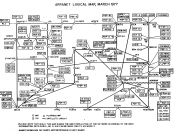An automated library is one where a computer system is used to
manage one or several of the library's key functions such as
acquisitions, serials control, cataloging, circulation and the public
access catalog. When exploring the history of library automation, it
is possible to return to past centuries when visionaries well before
the computer age created devices to assist with their book lending
systems. Even as far back as 1588, the invention of the French 'Book
Wheel' allowed scholars to rotate between books by stepping on a pedal
that turned a book table. Another interesting example was the 'Book
Indicator', developed by Albert Cotgreave in 1863. It housed miniature
books to represent books in the library's collection. The miniature
books were part of a design that made it possible to determine if a
book was in, out or overdue. These and many more examples of early
ingenuity in library systems exist, however, this paper will focus on
the more recent computer automation beginning in the early twentieth
century.
The Beginnings of Library Automation: 1930-1960
It could be said that library automation development began in the
1930's when punch card equipment was implemented for use in library
circulation and acquisitions. During the 30's and early 40's progress
on computer systems was slow which is not surprising, given the
Depression and World War II. In 1945, Vannevar Bush envisioned an
automated system that would store information, including books,
personal records and articles. Bush(1945) wrote about a hypothetical
'memex' system which he described as a mechanical library that would
allow a user to view stored information from several different access
points and look at several items simultaneously. His ideas are well
known as the basis for hypertext and mputers for their operations. The
first appeared at MIT, in 1957, with the development of...


